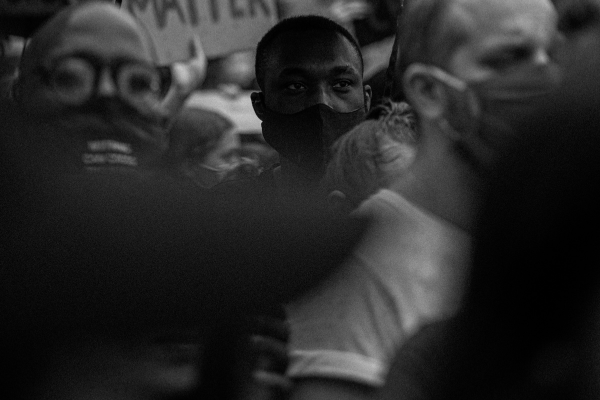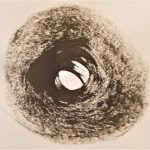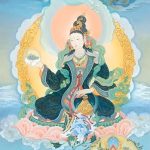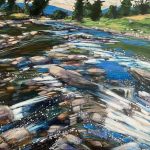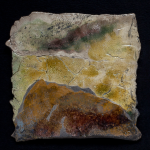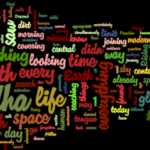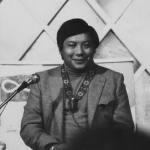Thursday
Baldwin and Buddhism: Death Denial, White Supremacy, and the Promise of Racial Justice
written by James K. Rowe
This is an excerpt of an essay originally published on December 16, 2020 in The Arrow: A Journal of Wakeful Society, Culture & Politics. The full essay is linked below.
“Terror cannot be remembered… Yet, what the memory repudiates controls the human being. What one does not remember dictates who one loves or fails to love.”
-James Baldwin
More attention should be paid to why white people remain so attached to narratives of racial supremacy. This was a sentiment shared by authors Rev. angel Kyodo williams and Resmaa Menakem in an online fireside chat held in the wake of Jacob Blake’s shooting in Kenosha, Wisconsin.1 If the purpose of radical analysis is to grasp injustices at their roots, then what might lie at the aching roots of white supremacy?
Menakem’s provocative answer, in his excellent book My Grandmother’s Hands: Racialized Trauma and the Pathway to Mending Our Hearts and Bodies, is that white supremacy is conditioned by generations of unprocessed trauma: “White bodies traumatized each other in Europe for centuries before they encountered Black and red bodies.”2 Left unprocessed, that trauma has helped fuel a will to racial supremacy that works emotionally to soothe people whose violent histories made them feel less-than.
A question that follows from Menakem’s powerful analysis is this: Why were Europeans dominating and traumatizing one another before their violence was directed towards Black and red bodies? In other words, is there an even deeper trauma that continues to condition a will to supremacy for white-bodied people?
James Baldwin thought so. In his powerful writings on whiteness, Baldwin argues that white supremacy is rooted in abiding terror.3 But what are white people terrified of? For Baldwin, white Euro-Americans lack the cultural resources for facing the existential reality of finitude, of death. In a powerful passage from The Fire Next Time, Baldwin observes that
“Americans cannot face reality, the fact that life is tragic. Life is tragic simply because the earth turns and the sun inexorably rises and sets, and one day, for each of us, the sun will go down for the last, last time. Perhaps the whole root of our trouble, the human trouble, is that we will sacrifice all the beauty of our lives, will imprison ourselves in totems, taboos, crosses, blood sacrifices, steeples, mosques, races, armies, flags, nations, in order to deny the fact of death, which is the only fact we have.”4
Although Baldwin uses collective pronouns in this passage, he concludes by specifying that “white Americans do not believe in death.” Likewise, in The Evidence of Things Not Seen, Baldwin observes that “whoever fears to die also imagines—must imagine—that another can die in his place.”5 For Baldwin, social constructions such as race and racism are mobilized as psychic buffers that help white people cope with their existential fears, albeit in infantile and destructive ways. More specifically, the fantasy of white racial superiority operates to soothe the primary vulnerability that white North Americans feel in the face of mortality. Unbearable feelings of being less-than in the face of finitude are softened with attractive illusions of being more-than vis-à-vis racialized people.
Baldwin is attuned to how race has historically been used strategically by American elites to divide the multiracial working class and to maintain class power.6 His existential analysis of whiteness, however, helps to explain why working-class whites have been so willing to choose racial over class solidarity. Gaining entrée into whiteness is a way of coping with historical trauma, as Menakem argues, but it is also a way to bear unprocessed existential trauma, particularly belittlement in the face of mortality, what the philosopher Hegel called “the absolute master.”7
For Baldwin, the ultimate hatred that white people need to overcome is the hatred they feel for themselves as mortal and vulnerable beings. If white North Americans could overcome this self-hatred by genuinely affirming human finitude, then they would be much less likely to conjure fantasies of compensatory supremacy. “White people in this country will have quite enough to do in learning how to accept and love themselves and each other,” writes Baldwin, “and when they have achieved this—which will not be tomorrow and may very well be never—the negro problem will no longer exist, for it will no longer be needed.”8
Learning from the Blues
While Baldwin gestures towards the universal force of existential fear, he is sensitive to different experiences and orientations toward mortality among white and Black cultures in North America. The historical legacies of slavery and white supremacy have made premature death all too present for Black people. In an essay on blues music, Baldwin describes the realities that the blues draw from: “work, love, death, floods, lynchings; in fact a series of disasters which can be summed up under the arbitrary heading ‘Facts of Life.’”9 It is telling that the political terror of lynching is shared in the same breath as primarily existential or “natural” concerns: death, floods, meeting subsistence needs. White supremacy has overexposed Black people to the reality of finitude to the point where political violence is now part of the expected human terrain. But taking a dialectical outlook, Baldwin argues that elements of North American Black culture have managed to successfully transmute an overexposure to mortality into an honest reckoning with the existential reality of finitude, a reckoning that whites have mostly avoided.
To continue reading this article please head over to The Arrow by clicking here.
Author Archive
no responses - Posted 06.16.23
written by Nalika Gajaweera This is an excerpt of an essay originally published on May 13, 2021 in The Arrow: A Journal of Wakeful Society, Culture & Politics. The full essay is linked below. “I want to be one of the nicest human beings that this earth has seen,” ...continue
no responses - Posted 06.06.23
By Laurence Corman When I attended my first AA meeting, I was left a little bewildered when I was told that I did not have an alcohol problem because, despite my daily drinking, I was not experiencing blackouts and was able to enjoy healthy family relationships and ...continue
no responses - Posted 05.23.23
Interview with John McQuade On June 3, 2023, John McQuade will begin the five-session summer course Contemplative Photography and Liberation: The Outer and Inner Teachings with Shambhala Online. Participants of all levels will take a deep dive into the world of Miksang Contemplative photography exploring the liberation aspects of ...continue
no responses - Posted 05.17.23
By Holly Gayley Holly Gayley discusses the power of Padmasambhava’s foremost disciple and consort, Yeshe Tsogyal, and the life of one of her modern emanations. Yeshe Tsogyal is the preeminent lady of Tibetan Buddhism. While most—if not all—of what we know about her life is highly mythologized, she ...continue
no responses - Posted 05.12.23
Mary Lang An Excerpt from the Touching the Earth Collective Mai Newsletter Every month, we offer a space for one of the Collective’s members or friendsto share their work, art, or passion… Artist Statement My photographs are visual records of a sentient being, standing on the earth, expressions of grief ...continue
no responses - Posted 05.02.23
Shambhala Touching the Earth Collective By Paul T. Wegner What the teachings offer to overcome our environmental damage. People ask: What does it say in the Buddhist teachings about our actions and climate change? In the teachings of the Hinayana we are taught not to cause harm. The path ...continue
no responses - Posted 04.25.23
A Shambhala Blog Post Denise Blanc, MA teaches, coaches, and writes at the intersection of mindfulness, emotional intelligence, and conflict transformation. Her new book is Riverlogic: Tools to Transform Resistance and Create Flow in all of our Relationships. In this interview, Denise discusses how she drew inspiration from Pema Chödrön, ...continue
1 response - Posted 04.18.23
Shambhala Touching the Earth Collective Every month, we offer a space for one of the Collective’s members or friends to share their work, art, or passion… Artist Statement The elements of earth, water and fire are intrinsic when working with ceramic materials. Clay is a wonderful, luscious, malleable, strong ...continue
no responses - Posted 04.07.23
Spring Newsletter Ice in Yarne 2023 The Abbey community has recently emerged from another Yarne retreat. This monastic retreat, which dates back to the time of the Buddha, is one of the essential elements of a monastic community. “Yarne” means the rains retreat…generally observed in the summer months ...continue
no responses - Posted 03.21.23
By John McQuade “ When the warrior-students experience an environment where the dralas are present , where reality is present, where the possibilities of sanity are always there they can appreciate the mountains, the clouds, sky, sunshine, trees, flowers, brooks…intensely bright red and blue, brilliant white and ...continue
no responses - Posted 03.14.23
By David Takahashi The story of Buddha’s enlightenment goes like this. Tired of the same kind of search you’re on, he sat down under a tree, and he didn’t get up. He sat there, night and day, until he found the meaning of life. In the early ...continue
no responses - Posted 03.07.23
A Touching the Earth Collective Book Review by Gregory Webster Dougald Hine has a knack for timely interventions. In 2009 he collaborated with Paul Kingsnorth to write Uncivilisation, the manifesto that launched the Dark Mountain Project – soon to be described by the New York Times as ...continue
no responses - Posted 02.27.23
This year, Shambhala Day was on February 21. Centres, Groups, and Members joined from around the world to share in a moving and joyful live broadcast. The theme for the Shambhala Day 2023: Year of The Water Rabbit Live Broadcast was “Reflecting on the Practice of ...continue
no responses - Posted 02.24.23
A Shambhala Archives Odyssey By Jeanne Riordan I was contacted a couple of weeks before the Shambala Day Live Broadcast and asked to source a reading or poem by Chögyam Trungpa Rinpoche about the new year. The theme for the live broadcast was described as “Community” so I ...continue

